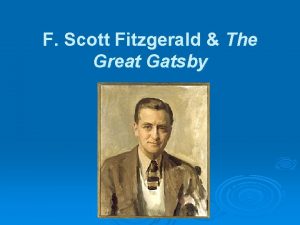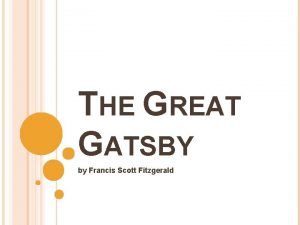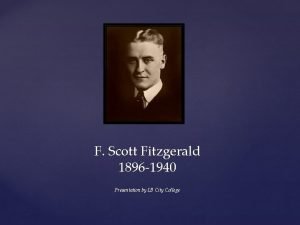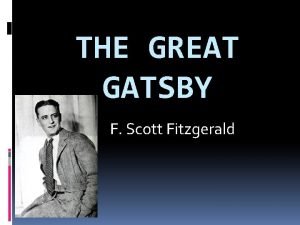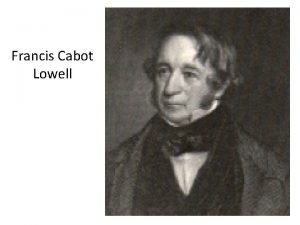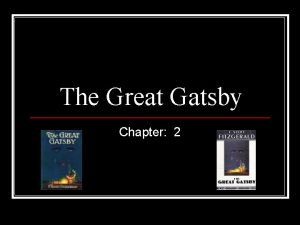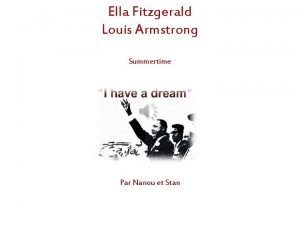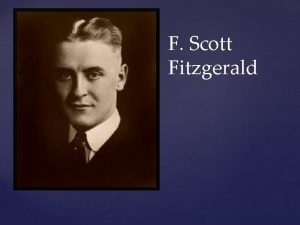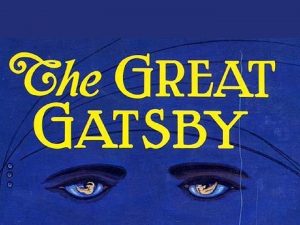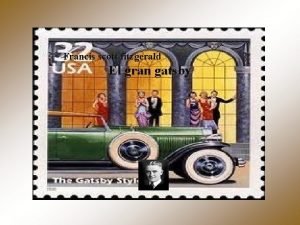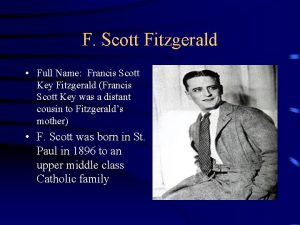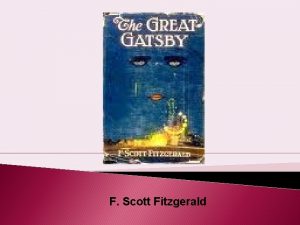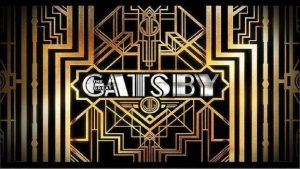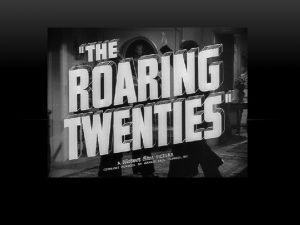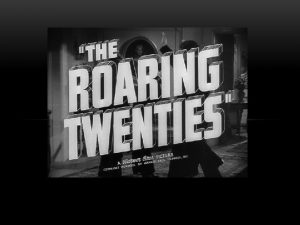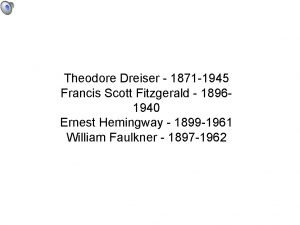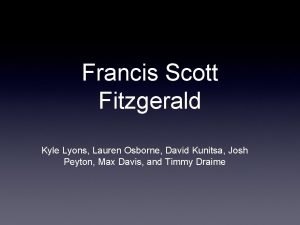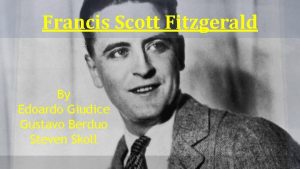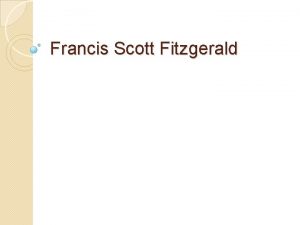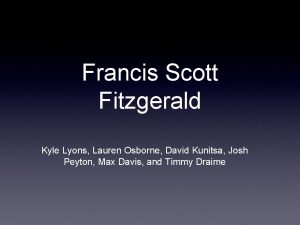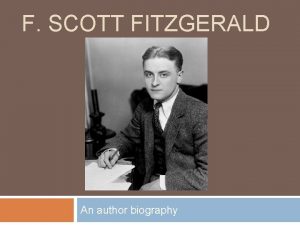F Scott Fitzgerald Francis Scott Key Fitzgerald was






















- Slides: 22

F. Scott Fitzgerald

• Francis Scott Key Fitzgerald was born in St. Paul, Minnesota on September 24, 1896. Family lived in San Mateo Flats, and had no electricity until 1911. • Two sisters, ages one and three, had died from influenza shortly before his birth. • Fitzgerald’s sister, Annabelle, born in 1901

• Although poor, family had social status. Fitzgerald was named after his second cousin, Francis Scott Key, the author of “The Star. Spangled Banner” (check out the stamp!)

• Fitzgerald’s family struggled • His father failed in furniture manufacturing. He became a salesman for Proctor & Gamble, but was fired • Fitzgerald’s mother, Mollie, had an inheritance. They moved to a brownstone “row house” in St. Paul, Minnesota, in Summit Terrace, an area inhabited by the city’s wealthiest residents.

Poor kid, Sponsored youth • Fitzgerald’s mother nurtured social ambitions in her only son. • An elderly helped finance his tuition at a private Catholic boarding school, and then, in 1913, at Princeton University. • Princeton U was viewed as a training ground for the American upper class.

• Coming from a background of “financial anxiety, ” while at Princeton, he developed a fascination with the very rich. • He was self-conscious about the differences between himself and his wealthy classmates.

• In 1917, Fitzgerald left Princeton in order to enlist in the United States Army. • Afraid that he might die in the war, Fitzgerald quickly finished a novel The Romantic Egoist. • Rejected from Charles Scribner’s Sons Pub. Encouraged to resubmit after revision.

• June 1918, stationed at Camp Sheridan, he (21) fell in love with Zelda Sayre (18). • A local debutante, the youngest daughter of an Alabama Supreme Court Judge. • Their romance intensified Fitzgerald’s desire to achieve success with his novel, but after revision, it was rejected a 2 nd time. • War ended before he left for France

• After WWI Fitzgerald went to New York to seek his fortune so that he could marry Zelda. Worked in advertising, and by night, he wrote stories. He received only rejection slips. Zelda broke their engagement. She was unwilling to live on his small salary (rich girls do not marry poor boys…)

Novel This Side of Paradise was a smashing success in March 1920. Fitzgerald was 23. Fitzgerald was perceived as the daring, intellectual style-setter for the times, and he achieved celebrity status. Zelda resumed their engagement. They married in New York in 1920.

Their only child, a daughter named Frances Scott (Scottie) Fitzgerald, was born in October 1921.

Fitzgerald’s life in the 1920 s mirrored events of the Roaring Twenties (“The Jazz Age”) A time of challenge to establishment, of personal indulgence, of excesses. Fitzgerald was its self-proclaimed spokesman.

Zelda was an aspiring dancer, craved attention, and had expensive taste. She also suffered from mental illness. Fitzgerald and Zelda drank alcohol publicly and partied often. Their tastes were for in New York’s luxurious Plaza Hotel, expensive and gigantic cars, country homes on Long Island or in Connecticut, and villas in France.

They spent more than he could make, and they found themselves in debt. Fitzgerald was to spend the rest of his life in a futile struggle to make ends meet. In 1922 Fitzgerald published The Beautiful and the Damned, about the self-indulgence and destruction of Anthony and Gloria Patch, based on Fitzgerald and Zelda, who were known for their glamorous but “unsettled” lives.

After his short story collection did poorly, he used his personal maturity, his experiences, his increasingly complex sense of his era’s place in world history, and his growing awareness of the modern novel to create The Great Gatsby.

Published in 1925, The Great Gatsby is frequently nominated as “the great American novel. ” A story of not only the 1920 s , but also borrows from his own American experience. It covers the exuberance as well as the malaise of the decade, focusing on America’s material success but also eroding values. The novels poor sales was a disappointment from which Fitzgerald never recovered.

Life in the second half of the 1920 s became desperate for the Fitzgeralds. As the Jazz Age drew to its traumatic close with the stock market crash of 1929, so did much of Fitzgerald’s life and career. Fitzgerald’s drinking got out of control, earning him the dubious title, “America’s Drunkest Writer. ”

In 1930 Zelda suffered the first of several complete nervous breakdowns. She spent the last eighteen years of her life in sanatoriums in Europe and the U. S. Fitzgerald’s fourth novel, Tender Is the Night, It tells the story of an American psychiatrist whose promising career is compromised by his wife’s madness, transparently basing it on Zelda.

To pay Zelda’s high medical bills and other debts, Fitzgerald wrote short stories The Saturday Evening Post and Esquire. He also worked in Hollywood as a screenwriter. On December 21, 1940, while he was in Hollywood, Fitzgerald died of a heart attack. He was 44 years old.

Fitzgerald and Zelda are buried together in St. Mary’s Cemetery in Rockville, Maryland. “So we beat on, boats against the current, borne back ceaselessly into the past. ”

The Great Gatsby Trivia A commercial flop! Eleven years after its publication, Fitzgerald estimated the novel had sold less than 25, 000 copies in the U. S. Fitzgerald’s last royalty had sales of 7 copies of The Great Gatsby in 1940. Twenty years later. . . a success! By 1945, The Great Gatsby was #8 on Bantam Publishing Co. ’s top ten titles. Today Gatsby is one of the best-selling novels ever; more than 15 million copies have been sold. Gatsby regularly produces more than $500, 000 a year in a trust for Fitzgerald’s grandchildren.

Francis Cugat’s jacket design for The Great Gatsby is the most celebrated and widely disseminated jacket art in American Literature. Cugat’s 1925 painting is iconic: the sad, hypnotic, heavily outlined eyes of a woman beam like car headlights through a cobalt night sky. Their irises are transfigured into reclining female nudes. From one of the eyes streams a green luminescent tear; brightly rouged lips complete the sensual triangle. Below, on earth, brightly colored carnival lights blaze before a metropolitan skyline.
 Francis scott key fitzgerald biography
Francis scott key fitzgerald biography Francis scott fitzgerald prezentace
Francis scott fitzgerald prezentace The great gatsby
The great gatsby F scott fitzgerald fun facts
F scott fitzgerald fun facts F scott fitzgerald grandchildren
F scott fitzgerald grandchildren F scott fitzgerald timeline
F scott fitzgerald timeline What was the waltham system
What was the waltham system Fitzgerald key method
Fitzgerald key method Heroes robert cormier quotes
Heroes robert cormier quotes Cost structure example business model canvas
Cost structure example business model canvas Contoh bisnis model canvas makanan pdf
Contoh bisnis model canvas makanan pdf The great gatsby chapter 2 summary
The great gatsby chapter 2 summary Hennebert sign
Hennebert sign Npxpert
Npxpert Fitzgerald health education associates
Fitzgerald health education associates Frances da silva
Frances da silva Porgy and bess summertime ella fitzgerald
Porgy and bess summertime ella fitzgerald Ehat is a ged
Ehat is a ged Dilbert certification
Dilbert certification Kms bismarck wreck
Kms bismarck wreck Styer-fitzgerald
Styer-fitzgerald Cantor fitzgerald dst
Cantor fitzgerald dst Ged fitzgerald
Ged fitzgerald
